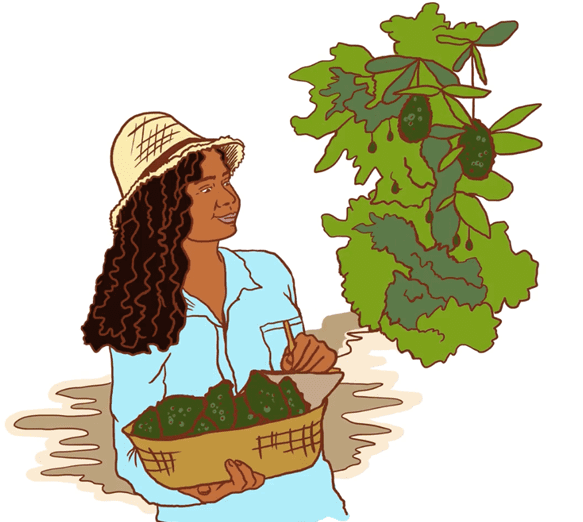Step 1: Introduction to Insurance for Farm Businesses

*Oahu RC&D worked closely with Farm Commons to develop these training materials and presentation. Weʻre are very grateful for their expertise in this field.
This course introduces you to the main types of insurance used by farm businesses, including: Property, Liability, and Crop & Livestock Insurance. The video accompanying this course is hosted by Farm Commons and delves into scearnios for when these various types of insurance are needed, along with exploring other risk-reducation tools such as Workers Compensation, Home owners or Rental Insurance and Contract Agreements.
Although crop and livestock insurance has been expensive in the past, new programs such as the Micro-Whole Farm Revenue program look like a promising way to protect the crops for small, diversified ag operations.
Property insurance generally covers damage to property from weather events, theft, or vandalism. Property insurance policies can also cover losses from equipment breakdown or loss of electrical power. The property covered can include buildings, tools, equipment, machinery, seed stock, animal feed, and so on.
Guest and customer injuries
Whether the farm hosts guests and customers, agritourism events, u-picks, farm stand sales, CSA pick-ups, or just a party, if someone were to get injured the farm could be on the hook. The farm could also be on the hook for injuries at off-site locations, such as a CSA drop site. Insurance coverage is a crucial risk management strategy for injuries. No matter how safe a farm is, any farm can be called into court to defend themselves. Insurance policies generally provide an attorney to defend the farm’s safety and compensate the injured person for his or her injury. Standard farm property and liability policies provide coverage for injuries to farm guests and customers. However, any off- farm or special activities such as events, processing, u-pick, and CSA drop sites, among others, may need individual endorsements, event riders, or separate policy lines.
Retail & Wholesale Sales
Farms selling to grocery stores and wholesale distributors may wish (or be required by the buyer) to carry a commercial general liability insurance policy. Commercial insurance extends the farm’s liability coverage to a broader set of circumstances including off-farm sales and coverage for things like indemnification and recall costs, to name a few possibilities. Some commercial policies provide some product liability coverage so any farmer with significant sales may want to explore this option.
Worker Injuries Farming is dangerous and worker injuries can and do happen no matter what precautions are taken. The most risk adverse approach is to carry workers’ compensation or other insurance to cover injuries for ALL of the farm’s workers, including employees, interns, and volunteers, whether required by law or not. If a farm does not carry workers’ compensation, the farm should explore other options as injured workers (or their health insurance companies) may sue the farm. A commercial policy may offer coverage for part-time and seasonal workers. For year-round employees, finding coverage other than workers’ compensation may be very difficult.
Crop & livestock insurance: Crop and livestock insurance covers the farm from significant loss caused by a natural disaster. Diversified farms traditionally have had limited options, but the Whole Farm Revenue Protection (WFRP) policy, now provides revenue coverage for diverse crop and livestock production.The WFRP policy covers a wide variety of naturally caused losses such as hail, disease, or flooding. The Micro-Whole Farm Revenue Program (Micro-WFRP) provides a similar insurance but for farms that have a much smaller annual profit. Multi-Peril Crop Insurance (MPCI) policies are available for selected commodities and regions, and provide coverage on an average market price basis. The Noninsured Crop Disaster Assistance Program (NAP) provides limited coverage for crops not otherwise insured through the Farm Service Agency (FSA).
How much coverage should I pay for?
Insurance policies have monetary limits; rare is the policy that will cover the full extent of the damage, no matter how great. These limits come in different forms. Specific covered items such as equipment and buildings may have limits on their replacement value.
Liability coverage for injuries and such will have total liability limits. Umbrella policies might be available to raise or distribute policy limits, but a limit remains. Generally, the more coverage the more expensive the premiums. Unfortunately, there’s no cut and dry equation for determining exactly how much insurance to get. A good starting point is to ask yourself the following questions:
• If a particular item was damaged, how what repair or replacement value would the farm business need to stay afloat?
• How high is the risk that such an incident or damage will occur?
• How devastating might a particular risk be if it materialized?
• Are buyers, partners, or other entities expecting a specific level of coverage?
• How much can the farm reasonably afford for insurance risk protection?
Consider more coverage for those items or aspects of your farm business where your discomfort with the risk is highest. The goal is to strike the right balance of not paying too much in premiums but paying enough to be sure that adequate coverage is available
if and when you need to file a claim.
Contract agreements can provide:
- More stable revenue streams and identification of the best times to diversify your operation;
- Avoidance of unanticipated financial fines or shut-downs;
- Clear agreements with your buyers and employees.
Insurance for Farms with Farm Commons
Watch this Video to learn what type of insurance is right for your farm. Topics covered in this video include:
- Production history and its relevance to crop insurance
- Introduction to using online insurance resources and tools
- Documenting inventory for disaster indemnification programs
- Understanding policy selections
- Understanding price and coverage levels
- Importance of unit selection
- Types of insurance policies and options within each type
- Filing a claim
- Whole Farm Revenue Protection
- Covered and non-covered crops
- Livestock policies
- Sales closing and acreage reporting deadlines
- Relationship building with insurance agents and other ag influencers
- Increasing skills to evaluate and use crop insurance programs due to limiting financial factors
- Written agreements where crop insurance is not available
- How to use record keeping to obtain crop insurance, disaster assistance, loan and lease agreements
